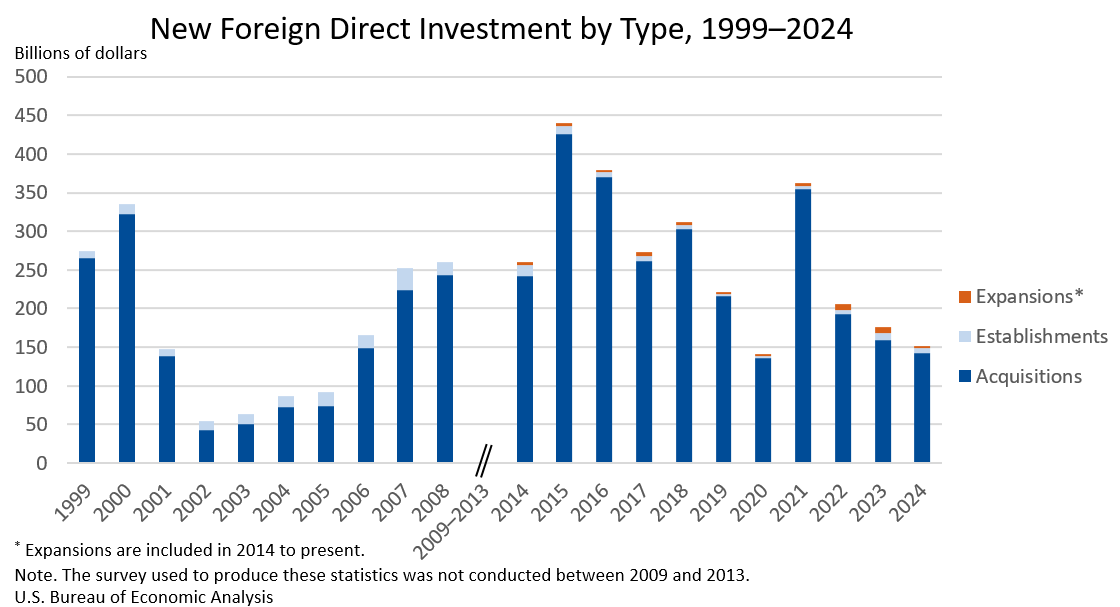Bureau of Economic Analysis
New Foreign Direct Investment in the United States, 2024
Expenditures by foreign direct investors to acquire, establish, or expand U.S. businesses totaled $151.0 billion in 2024, according to preliminary statistics released today by the U.S. Bureau of Economic Analysis. Expenditures decreased $24.9 billion, or 14.2 percent, from $176.0 billion (revised) in 2023 and were below the annual average of $277.2 billion for 2014–2023. As in previous years, acquisitions of existing U.S. businesses accounted for most of the expenditures.
Principal Federal Economic Indicators
Noteworthy
- 2025 News Release Schedule
- Innovation at BEA
- 2025 Annual Updates
- New! Services Trade Data for More Countries
- Data Tool: Trade in Value Added
- Distribution of State Personal Income
- Updated: RIMS II Regional Multipliers
- Arts and Culture
- Space Economy
- FDI Now in State BEARFACTS
- Quick Guide: Price Indexes
The Latest
State Quarterly Personal Income, 1st quarter 2017
State personal income growth accelerated to 1.0 percent on average in the first quarter of 2017 from 0.3 percent in the fourth quarter of 2016, according to estimates released today by the Bureau of Economic Analysis (table 1). Earnings and personal current transfer receipts were the leading contributors to growth for the nation and in most states (table 2).
State Personal Income, First Quarter 2017
Real spending (output) on travel and tourism turned up in the first quarter of 2017, increasing at an annual rate of 0.4 percent after decreasing 2.7 percent (revised) in the fourth quarter of 2016, according to new statistics released by the Bureau of Economic Analysis. In contrast, real gross domestic product (GDP) for the nation decelerated, increasing 1.2 percent in the first quarter (second estimate) after increasing 2.1 percent in the…
Travel and Tourism Spending Turned Up in the First Quarter
Real spending (output) on travel and tourism turned up in the first quarter of 2017, increasing at an annual rate of 0.4 percent after decreasing 2.7 percent (revised) in the fourth quarter of 2016, according to new statistics released by the Bureau of Economic Analysis. In contrast, real gross domestic product (GDP) for the nation decelerated, increasing 1.2 percent in the first quarter (second estimate) after increasing 2.1 percent in the…
Travel and Tourism Satellite Accounts, 1st quarter 2017
Real spending (output) on travel and tourism turned up in the first quarter of 2017, increasing at an annual rate of 0.4 percent after decreasing 2.7 percent (revised) in the fourth quarter of 2016, according to new statistics released by the Bureau of Economic Analysis. In contrast, real gross domestic product (GDP) for the nation decelerated, increasing 1.2 percent in the first quarter (second estimate) after increasing 2.1 percent in the…
Real Personal Income for Metropolitan Areas, 2015
Growth of real personal income for metropolitan areas — an area’s current-dollar personal income adjusted by its regional price parity (RPP) and the national personal consumption expenditure (PCE) price index — ranged from -10.1 percent in Midland, TX to 9.9 percent in Carson City, NV.
Real Personal Income for States, 2015
Growth of real state personal income — a state’s current-dollar personal income adjusted by the state’sregional price parity (RPP) and the national personal consumption expenditure (PCE) price index —ranged from -2.3 percent in North Dakota to 7.0 percent in Delaware.
Real Personal Income for States and Metropolitan Areas, 2015
Real state personal income grew on average 4.1 percent in 2015, after increasing 3.6 percent in 2014. Growth of real state personal income ranged from -2.3 percent in North Dakota to 7.0 percent in Delaware. Across metropolitan areas, growth ranged from -10.1 percent in Midland, TX to 9.9 percent in Carson City, NV.
U.S. Current-Account Deficit Increases in First Quarter 2017
Errata: Numbers in this blog have been corrected. Net U.S. borrowing from financial-account transactions now stands at $115.3 billion in the first quarter. Net U.S. incurrence of liabilities excluding financial derivatives is $395.0 billion.
U.S. International Transactions, 1st quarter 2017 and annual update
ERRATA Tables 1 and 7 and relevant text in the "U.S. International Transactions: First Quarter 2017 and Annual Update" news release and corresponding statistics in the Interactive Tables were corrected on July 5, 2017. The corrections affect statistics for net U.S. incurrence of portfolio investment long-term debt liabilities and related aggregate statistics for the first quarter of 2017; related statistics for U.S.
April 2017 Trade Gap is $47.6 Billion
The U.S. monthly international trade deficit increased in April 2017 according to the U.S. Bureau of Economic Analysis and the U.S. Census Bureau. The deficit increased from $45.3 billion in March (revised) to $47.6 billion in April, as exports decreased and imports increased. The previously published March deficit was $43.7 billion. The goods deficit increased $2.3 billion in April to $68.4 billion. The services surplus decreased less than $…




